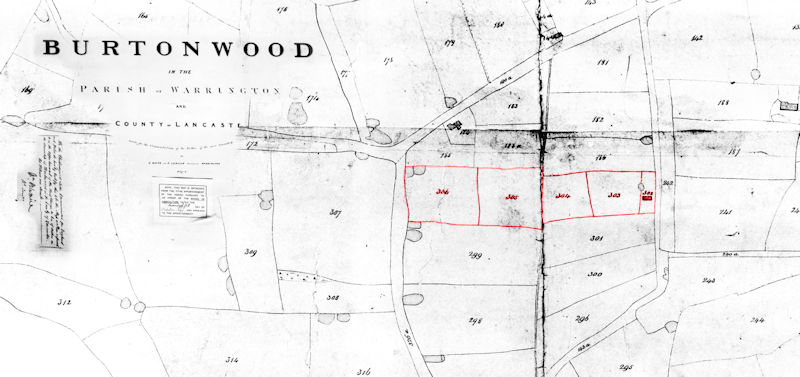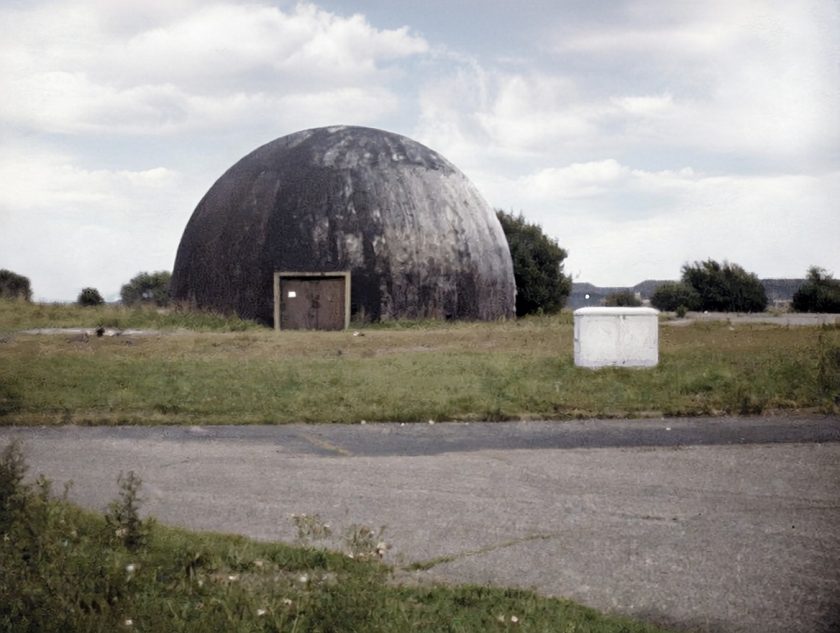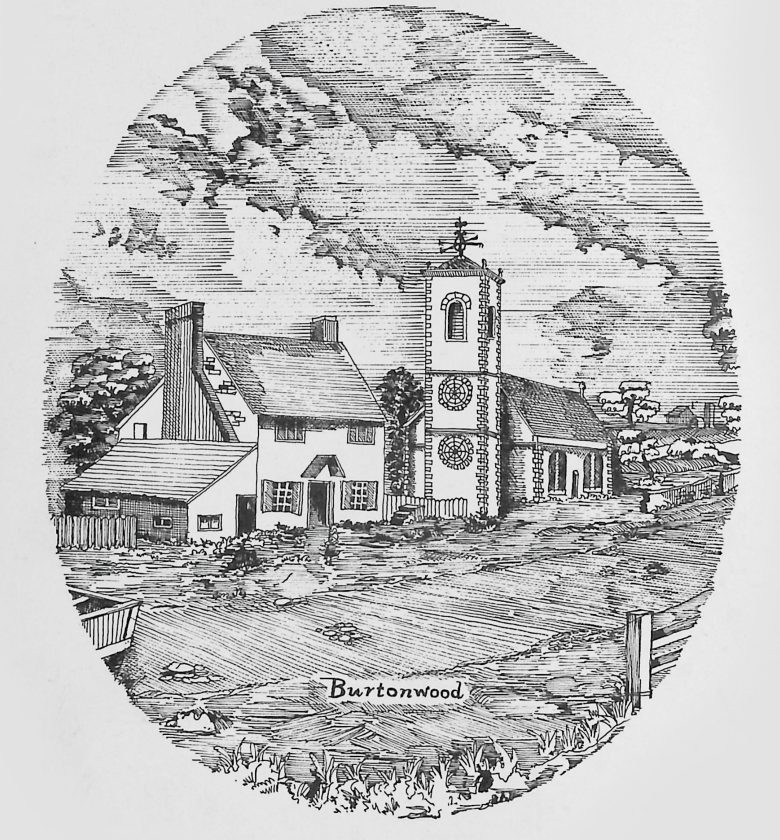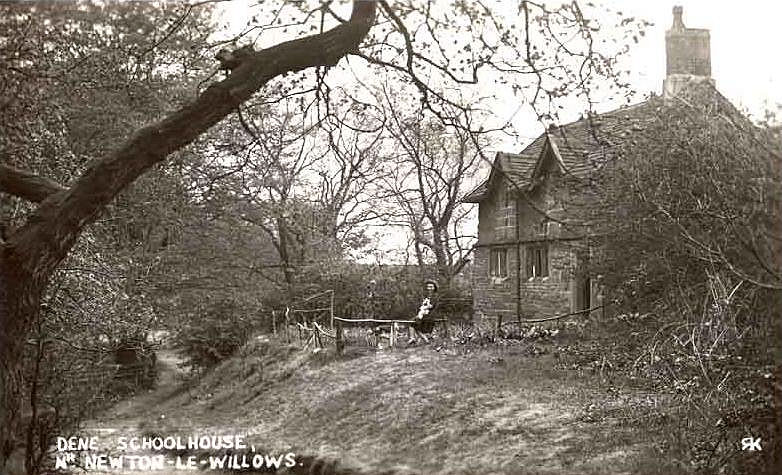“Warrington Church Notes” by William Beamont, published in 1878, is a historical account focusing on the Parish Church of St. Elfin in Warrington, England, along with other churches in the parish. William Beamont was a noted historian and antiquarian of the 19th century, particularly well-regarded for his contributions to the local history of Warrington and the surrounding areas.
In this publication, Beamont documented the history, architecture, and significant events associated with the churches in the different Warrington parish’s. This is what he wrote about the history of the Burtonwood Parish.
BURTONWOOD CHAPEL
Burtonwood, though part of the parish of Warrington, was most inconveniently placed in respect to the Parish Church. In early times, the people there must have found it less easy to resort to their own parish church than to frequent the church services either at Newton, where as early as the year 1285 Sir Robert Banastre, Baron of Newton, had founded his chantry of Rokeden, or at Winwick, where Sir Gilbert de Haydock in 1330 had founded the chantry of the Holy Trinity, of which the lords of Bradley, a hamlet in Burtonwood, afterwards became the patrons.
Neither of these accommodations having been found sufficient to supply the spiritual needs of the people, it occurred to the mind of a Burtonwood landowner to carry out the wishes of Thomas Darbyshire, a benevolent deceased testator, to provide the people a place of worship within their own township. To accomplish this object, he executed in the year 1605 a deed, the following being a translation from the Latin original:
“To all to whom this present indenture shall come, Thomas Bold, of Bold, in the county of Lancaster, Esquire, sends health and greeting in the Lord. Know ye that I, the aforesaid Thomas Bold, for divers good causes and considerations me thereunto moving, have given, granted, and by this my present writing have confirmed to Ralph Taylor, Nicholas Crofte, Thomas Crofte, William Rowlinson, Thomas Phipp, and George Cowpe, of Burtonwood, in the said county, yeomen, a portion of my land and hereditaments, part of the unimproved waste there, lying and being near the tenement of the aforesaid Thomas Phipp, in Burtonwood aforesaid, and containing in length forty yards, and in breadth twenty-four yards, be the same more or less as it is now divided and separated from the aforesaid waste with its appurtenances.
To have and to hold the aforesaid portion of land and hereditaments with their appurtenances to the aforesaid Ralph Taylor, Nicholas Crofte, Thomas Crofte, William Rowlinson, Thomas Phipp, and George Cowpe, their heirs and assigns forever to the use, confidence, intent, and purpose in a certain schedule to this present indented writing annexed expressed and declared and to no other use, intent, or purpose. To hold of the capital lords of the fee by the service theretofore due and of right accustomed, and also rendering to me, my heirs, and assigns the yearly rent of one penny of lawful English money on the feast of the nativity of St. John the Baptist for all demands, and I, the said Thomas Bold, and my heirs, the aforesaid portion of land and hereditaments, with their appurtenances, to the aforesaid Ralph Taylor, Nicholas Crofte, Thomas Crofte, William Rowlinson, Thomas Phipp, and George Cowpe, their heirs, and assigns, to the use, intents, and purposes in the aforesaid schedule mentioned and declared, will by these presents warrant and forever defend against all men whomsoever.
In testimony whereof, the parties of both parts to these presents to this present charter indented have interchangeably set their seals. Dated the twenty-seventh day of September, in the third year of the reign of our sovereign Lord James, by the grace of God King of England, France, and Ireland, and of Scotland, the thirty-ninth, 1605.”
On the back of the deed, there is endorsed the following memorandum:
“Sealed and delivered upon the within named portion of land and livery and seisin thereof made, and the within named parties enfeoffed by the within named Thomas Bold in the presence of Ja. Pemberton, Thomas Denton, Tho. Dancaster, John Taylor, William Cowley, Richard Penketh, Nicholas Bate, Fra. Wilkinson.”
It may be observed in passing that this deed is dated only five weeks and four days before the discovery of the gunpowder treason. The schedule referred to in the foregoing deed is as follows:
“Know all men by these presents that I, the said Thomas Bold, as well for the consideration in the said deed of feoffment expressed as also for the goodwill and affection, I bear that God may be the better served, divine service used and continued in Burtonwood, as mentioned in the said deed of feoffment, as also that the young people and children thereabouts may be nourished in learning according to the good meaning expressed in the testament and last will of Thomas Darbishire, deceased, as also for divers other good causes and considerations me at this time moving have made the said deed of feoffment whereunto this schedule indented is annexed, to the uses, trusts, and intents hereafter in this schedule expressed and declared.
Wherefore I, the said Thomas Bold, do now by these presents openly publish, set forth and declare that the very true intent and meaning of the making of the said deed of feoffment and the execution thereupon to be had and made is and shall be that the said Raphe Taylor, Nicholas Crofte, Thomas Crofte, William Rowlinson, Thomas Phipp, and George Cowp, the feoffees named in the said deed of feoffment, shall presently after the execution of the same deed stand and be seised of the said portion of land and hereditaments mentioned in the same deed, and of every parcel thereof, with the appurtenances to the only use and behoof of the said Raphe Taylor, Nicholas Crofte, Thomas Crofte, William Rawlinson, Thomas Phipp, and George Cowp, and of their heirs and assigns forever.
Nevertheless, upon trust and to the intent to perform the limitations, orders, directions, and true meaning ensuing, that is to say, that the said Raphe Taylor, and his said co-feoffees named in the said deed of feoffment, their heirs and assigns, and the survivor of them or some of them, in convenient time, shall erect or cause to be erected one chapel or house of prayer in and upon the said lands mentioned in the said deed of feoffment, or upon some part thereof, which from thenceforth shall be called and named Burtonwood Chapel, and shall likewise from time to time, and at all times after the erection or building thereof, sufficiently repair and uphold the same.
Also, the said feoffees or the survivors of them, or the greatest number of them, then surviving, their heirs and assigns, shall faithfully and truly, according to the meaning of the said Thomas Darbishire, expressed in his said testament and last will, elect and choose lawful and fit persons to read divine service and teach grammar school at the said chapel, within convenient time after the same is erected, built, and furnished for the same, and so often as the same shall become void or be without any such incumbent or fit person to read divine service and teach grammar school there forever, and shall set down and determine of orders, directions, and rules for the government and ordering of the said chapel and school, and of such chaplain, incumbent, or schoolmaster from time to time as to the said feoffees and their heirs and assigns, or the greater number of them, shall be thought meet.
For the perfect assurance that the said portion of lands and hereditaments and other the premises expressed in the said deed of feoffment shall assuredly continue to the uses and purposes aforesaid, I, the said Thomas Bold, for the considerations aforesaid, and the yearly rent reserved in the said deed of feoffment, do for me and my heirs covenant and grant to and with the said Raphe Taylor and the other his said co-feoffees and their heirs and assigns by these presents. That as well I, the said Thomas Bold, my heirs and assigns, as also every other person and persons now seised or hereafter to be seised of the said portion of lands and hereditaments with its appurtenances, whatsoever shall stand and be thereof and of every parcel thereof seised to the uses, trusts, true intent, and meaning before in these presents expressed and declared, and to none other use, meaning, or purpose in any wise.
Likewise, that all fines, feoffaments, recoveries, and other conveyances and assurances whatsoever hereafter to be had, made, or suffered thereof by me, the said Thomas Bold, my heirs and assigns, or any of us, shall be to the uses, true intent, and meaning aforesaid, and to none other use or intent in any wise. Lastly, it is the mind and full intent of me, the said Thomas Bold, and of the making hereof, that when any of my said feoffees shall die or depart the said town of Burtonwood to dwell elsewhere or be disabled in person for any cause that then and in such case or cases, within one month after it shall be lawful for the residue of my said feoffees, then living in Burtonwood aforesaid (not disabled) to elect other honest person or persons of the said town of Burtonwood to supply the rooms of such defect for the government, order, and direction of the said chapel, chaplain, and schoolmaster.
Also, that the survivors of my said feoffees, or the two last and longest surviving of them, shall make feoffment or feoffments of the premises unto such other person or persons so elected, or to be elected within Burtonwood aforesaid, to the number of six at the least who shall be governors and feoffees as aforesaid, and to their heirs and assigns forever,
to the uses and intents before said, and that such elections of persons and making of feoffments, when, and as often as occasion shall require, be used and continued forever, according to the true meaning of me, the said Thomas Bold, and of the good intention expressed in the said testament and last will of the said Thomas Darbishire, and no otherwise.
In witness whereof, as well to this present schedule indented as also to the said deed of feoffment hereunto annexed, I, the said Thomas Bold, have put my hand and seal the day and year in the said deed mentioned.-THO. BOLD.”
The chapel having been completed soon after the year 1605, no time was lost in supplying it with a minister to perform Divine service in it and to conduct the school attached to it. Of the first minister and of those who followed him, we shall give such an account as we have been able to find; but unhappily, in some cases, the account must consist of little more than their names.
MINISTERS AND VICARS OF BURTONWOOD
I. MR. THOMAS HINDLE, who was appointed about 1605, and whose name is met with as the first minister, had no chronicler to hand down his biography to later times. However, he did his duties faithfully among his scattered flock, and in 1632, he died and was buried at Winwick on the 16th of June, where the register expressly describes him as the minister of Burtonwood. (Winwick register.)
II. 1632. WILLIAM BAGALEY, who succeeded to the chapel on Mr. Hindles’ death, is stated to have come in by the election of the inhabitants or the major part of them. Two years later, on the 16th of December, 1634, the chapel was consecrated by the Right Reverend John Lord Bishop of Chester, in the presence of Richard Bold, Esquire, Thomas Ireland, Esquire, of Bewsey, and divers other inhabitants of Burtonwood. Neither Bagaley’s nor any other name appears for Burtonwood in 1646 among the ministers of the Lancashire classis. But in 1648, when Mr. Heyrick’s harmonious consent was signed, Mr. Bagaley signed it and described himself as the minister of Burtonwood. (Hist. Coll. Church of Manchester-397.)
An old house, built in this year and still standing not far from the chapel, has this inscription: G.I.T.C.E.G.I.C.I., 1648. In 1650, when a plan was drawn up for dividing Warrington parish, Burtonwood Chapel was proposed to be made the center of a new and separate parish. Mr. Bagaley is stated to be weak and not qualified to teach and that he constantly made marriages contrary to the directory and rules appointed by an order of Parliament, leading to his removal by the independent party to make way for his successor.
III. 1660. SAMUEL MATHER, M.A., son of the well-known Richard Mather, M.A., was born at Much Woolton. He accompanied his father, who was one of the Pilgrim fathers, to America in 1635. His memoirs provide this account of their journey to Bristol, where they embarked: “We left Liverpool on the 15th April, reached Warrington the next day, and Bristol on the 23rd, having had a healthy, safe, and prosperous journey all the way, taking but easy journeys because of the women and children. The party reached Boston after their voyage from Bristol on the 17th of August, 1635.”
We do not know how soon the son returned to England, or whether he was Mr. Bagaley’s immediate successor; but in 1660, he was officiating as the minister of Burtonwood. In 1662, however, he left under the Bartholomew Act. This entry in the Warrington parish register relates to Mr. Mather’s daughter: “1662, June 26th. Buried Martha, the daughter of Mr. Mather, minister.”
A long memoir of Mr. Mather’s father is given in Calamy’s Nonconform. I., 415, and in the History of New England, IV., c. 2, p. 143.
IV. 1676. JOHN CHENEY, the minister of Burtonwood, on the 23rd of January, 1676, held a public disputation with the Quakers at Arley Hall, near Blackrode, in Lancashire. He wrote a work called “A Skirmish with the Quakers,” and another work called “A Warning to Souls,” both mentioned in the writings of Roger Haydock. (Dr. Kendrick’s Warrington Worthies).
V. 1680. JOHN HEAPIE is mentioned as minister of Burtonwood in this year. (Warrington register.) He was minister at the passing of the Toleration Act, and probably also when the following certificate was obtained two years later for licensing another place of worship in Burtonwood:
“20th July, 1690. These are to certify those whom it may concern that the house of Peter Gaskell, of Burtonwood, in this county, now certified to this Court for a meeting place for a congregation of Protestants dissenting from the Church of England for the exercise of their religious worship is (pursuant to a late Act of Parliament in that case made and provided) recorded at this present Quarter Sessions. Given under my hand in open Court of Quarter Sessions, at Ormskirk, the day and year above written. ROGER KENYON. Clerk of the Peace.”
VI. WILLIAM SUMNER was the next minister who succeeded Mr. Heapie at Burtonwood. The exact date when he came to the living is not known, but he was probably minister before 1694, when there was a collection made for the distressed Protestants driven from France by the revocation of the Edict of Nantes in 1685. Collections were ordered to be made for this purpose soon after the edict was revoked. When they were first ordered, Dr. Burgess objected to Archbishop Tillotson’s giving orders for them, but the Archbishop silenced him by saying, “Oh, Doctor, Doctor, charity is above creeds,” and the collections were accordingly made, raising a very large sum for the succor of this deserving people.
There may have been previous collections made for them at Warrington before 1694, but in that year the sums raised were as follows:
Money collected by briefs for the French Protestants in the parish of Warrington:
Place £ s. d.
Warrington 5 2 5 1/2
Burtonwood 8 4 1/2
Woolston 16 4 1/2
Rixton with Glazebrook 6 10
In 1700, this entry appears in the parish books: “For making up of the proportion of £5 3s. 4d. to Burtonwood, Mr. S. Borron is to pay 4d. for a Church ley for meadowing in Arpley, and Mr. Earl 8d., a Church ley for Mount Hill (the present St. Elfin’s) to the churchwardens of Burtonwood.” This means that land lying in Warrington was to contribute part to the church rate of Burtonwood. For some reason, probably because the lord of the manor, before he removed to Bewsey, had had his seat upon the Mount Hill, it continued to be considered part of Burtonwood.
Another regulation in the same book was that the churchwarden was to charge nothing for drawing or making his accounts if he could write, which though not intended, was in fact giving an advantage to the illiterate over the literate. On the 27th of May, 1701, when the second terrier of Warrington was drawn up, we have in it this notice of Burtonwood: “There are two chapels in our parish, Hollinfare and Burtonwood. Hollinfare is not supplied, but when I (Mr. Shaw) officiate as king’s preacher because it hath now no endowment, the £4 12s. which used to be paid out of the duchy, having for some years been discontinued, Burtonwood is supplied by Mr. William Sumner, who receives £4 from the endowment of the chapel and the rest of his maintenance depends upon contributions.”
Mr. Sumner, who was probably of a respectable family of the neighborhood, continued to officiate at Burtonwood for some ten or twelve years in all.
VII. JAMES BANKS, who next succeeded to this small benefice, occurs in the terrier of Warrington parish drawn up on the 22nd of July, 1712, and the entry in it is as follows:
“There are two chapels in our parish, Hollin-ferry and Burtonwood. Hollin-ferry is supplied by Mr. John Collier (the father of the celebrated humorist Tim Bobbin), and hath the endowment of £4 12s., the benefit of seats in the gallery and some interest money and the rest of the money is made up of contributions. Mr. James Banks at present supplies Burtonwood and is to receive £4 yearly from the endowment of the chapel, and the rest of his maintenance is made up of contributions.”
On the 24th of May, 1717, the same entry is repeated almost verbatim, Mr. James Banks being still minister.
VIII. ROBERT CHAPMAN, the next minister, who perhaps was not Mr. Banks’ immediate successor, has left little account except that he resigned the living in 1757. (The episcopal registry at Chester.)
IX. MR. KIRBY was the next minister of Burtonwood, and of him also, we have been unable to obtain any particulars. He probably held the living until 1790.
X. JAMES CAWLEY, M.A., was the next minister, who probably took the living from a love of the work and for the sake of the flock, and not their fleece. He was the son of Mr. William Cawley, the head of a respectable family at Dallam, in Burtonwood. He entered the Manchester Grammar School on the 3rd of March, 1775, where he greatly distinguished himself, and in 1782 obtained a school exhibition to Brasenose College, Oxford. On the 26th of January, 1786, he succeeded to a Hulmean exhibition and was afterward elected a Fellow of his College.
He had graduated B.A. on the 26th of January, 1786, and M.A. on the 23rd of October, 1788. On taking his Fellowship, he entered into holy orders, and though he refused a lucrative College living, he took charge of the small church of Burtonwood, where if he had had no other means, he might have wanted bread. He resigned his Fellowship in 1797, but he continued to hold the church of Burtonwood until about 1808. He maintained throughout life the character of an amiable and excellent man; he was a man of very unobtrusive and retiring habits, and to the last, he declined to take any better benefice than Burtonwood.
About 1808, he retired to Runcorn Heath, where he devoted himself to the education of his children, taking a great interest in all works of charity, and there he died about 1830. He left two sons, James, who died leaving a son who took holy orders; and William, who is believed to be still living. (Manchester School Register, Chet. So., vol. i. 213, 14.)
XI. ROBERT BARLOW, who about the year 1808 succeeded Mr. Cawley as minister of Burtonwood, was at the same time appointed master of the Free Grammar School at Winwick. Mr. Barlow was remarkable for his beautiful reading and for the effective manner in which he delivered his sermons, which led to his often being selected to preach charity and other sermons on public occasions.
In 1808, he preached and afterward printed a sermon at Manchester on the proneness of a philosophizing spirit to embrace error, with remarks on Mr. Lancaster’s system of education. In conducting his school at Winwick, Mr. Barlow was not an Orbilius like his predecessor there, and when he died this earned for him the character of Benignus in the epitaph written upon him by one of his former pupils.
In 1822, he resigned both Burtonwood and his school and accepted the living of Lower Peover, in Cheshire, where he died on the 23rd of January, 1823. A marble tablet to mark the place of his remains was set up in that church by his pupils. The Winwick register records the birth of Robert John, son of Robert and Catherine Barlow, on the 19th of January, 1819, and of William, son of the same, in 1821.
XII. JOHN WILLIAMSON succeeded Mr. Barlow both in the living of Burtonwood and the school. In 1828, when the Charity Commissioners had the school under their notice, he drew upon himself their severe but just animadversions for his neglect of the school. (Report on Lancashire Charities, pp. 196, 972.) He died about the year 1828, at Southport, where he had for some time resided.
XIII. WILLIAM GARNETT THOMAS, M.A., who succeeded Mr. Williamson, was a native of the West Indies. He was entered at Trinity College, Cambridge, where he took his M.A. degree in 1822, and in 1829 he accepted the living of Burtonwood and soon afterward came to reside in the parish.
Leaving to others more ambitious than himself who graduated at the same time and obtained higher positions, he lived contented with the parish work he loved and in which he was interested. He resided constantly among his people, lived peaceably with all men, and except on errands of benevolence or charity, was rarely or never absent from his place. When he first took the cure, Burtonwood was a less populous and more rural place than it is now; but he sought no change, and to him might be applied the poet’s words:
“Remote from towns he ran his godly race, Nor e’er had changed nor wished to change his place.”
After serving the cure for 45 years, Mr. Thomas resigned Burtonwood in 1874, and to the regret of his flock, retired to live with his friends.
XIV. WILLIAM WILSON, the present worthy Vicar, was appointed in 1876.
This was transcribed by Steven Dowd from an original copy of “The parish church of St. Elfin, Warrington, and the other churches of the parish, by William Beamont” published in 1878.



